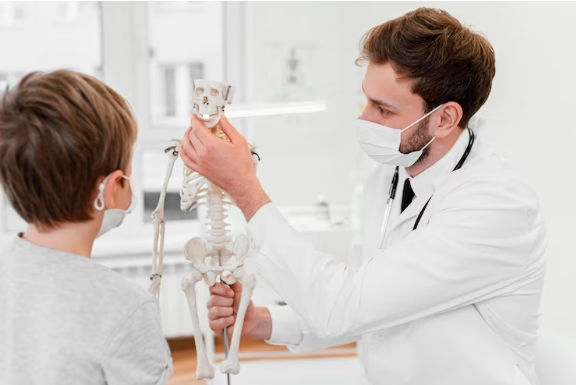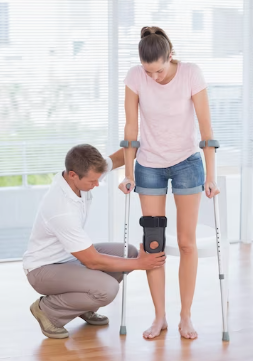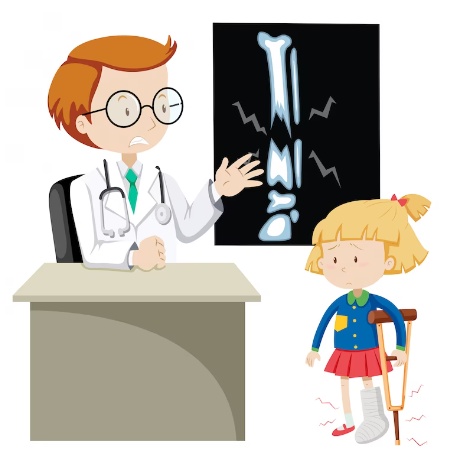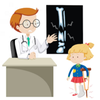Children are often full of energy, constantly exploring and engaging in various activities. Unfortunately, their active lifestyles can sometimes lead to injuries, including fractures. Pediatric fractures, or broken bones in children, require special attention and understanding due to the unique nature of a child's growing bones. In this article, we will explore the different types of pediatric fractures, their causes, symptoms, diagnosis, treatment options, prevention strategies, and the role of orthopedic specialists in managing these injuries.
Introduction
Pediatric fractures refer to the breakage or disruption of a bone in a child's body. These fractures can vary in severity and location, often requiring specific approaches for diagnosis and treatment. Understanding the types of pediatric fractures is crucial for parents, caregivers, and healthcare professionals to ensure appropriate care and promote the healing process.
Types of Pediatric Fractures
-
Complete Fractures
- Definition: Complete separation of the bone into two or more pieces.
- Common in children due to falls, sports injuries, or accidents.
- Subtypes: Transverse, oblique, spiral, and comminuted fractures.
-
Incomplete Fractures
- Definition: Partial breakage of the bone, where the bone is not completely separated.
- Common in children due to their softer and more flexible bones.
- Subtypes: Greenstick fractures, torus fractures, and buckle fractures.
-
Greenstick Fractures
- Definition: Incomplete fracture with one side of the bone bending or buckling, while the other side remains intact.
- Common in children due to their bones' elasticity and higher water content.
-
Torus Fractures
- Definition: Incomplete fracture with a bulging or buckling of the bone cortex.
- Commonly found in the forearm and wrist.
-
Buckle Fractures
- Definition: Incomplete fracture with compression or buckling of the bone.
- Frequently seen in the wrist and growth plates.
-
Physeal Fractures
- Definition: Fractures that involve the growth plate (physis) at the end of long bones.
- Crucial to monitor and treat appropriately to prevent growth disturbances.
-
Stress Fractures
- Definition: Tiny cracks in the bone caused by repetitive stress or overuse.
- Often seen in athletes or children involved in high-impact activities.
Causes and Risk Factors
Pediatric fractures can occur due to various causes and risk factors. Understanding these factors can help in preventing such injuries and providing appropriate care when they do occur. Some common causes and risk factors include:
- Traumatic injuries from accidents, falls, or sports-related activities.
- Playground accidents, such as falls from equipment or collisions with other children.
- Child abuse, which can result in fractures of different types and locations.
- Weaker bones due to osteoporosis, bone disorders, or certain medical conditions.
- Insufficient calcium and vitamin D intake, leading to decreased bone strength.

Signs and Symptoms
Recognizing the signs and symptoms of pediatric fractures is essential for early detection and prompt treatment. The following indicators may suggest a fracture:
- Persistent pain or discomfort, especially with movement or weight-bearing.
- Swelling or bruising around the injured area.
- Visible deformity or misalignment of the affected limb.
- Limited range of motion or difficulty in using the injured body part.
- Bruising or discoloration of the skin near the fracture site.
Diagnosis and Imaging Techniques
To accurately diagnose pediatric fractures, healthcare professionals employ various imaging techniques alongside a thorough physical examination. These techniques include:
- Physical examination: Assessing the affected area for tenderness, swelling, deformity, and range of motion.
- X-rays (radiographs): Commonly used to visualize fractures and determine their location and severity.
- Magnetic Resonance Imaging (MRI) scans: Provides detailed images of soft tissues, joints, and growth plates.
- Computed Tomography (CT) scans: Useful for assessing complex fractures, joint involvement, or bone fragments.
Treatment Options
The treatment of pediatric fractures depends on the type, severity, and location of the fracture, as well as the child's age and overall health. Common treatment options include:
- Casting and splinting: Immobilizing the fracture with a cast or splint to allow for proper healing.
- Reduction and immobilization: Realignment of the fractured bone followed by immobilization.
- Surgical intervention: Required for complex fractures that cannot be effectively treated with casting or reduction alone.
- Rehabilitation and physical therapy: Helps restore strength, mobility, and function after the fracture has healed.
Prevention and Safety Measures
Preventing pediatric fractures involves implementing appropriate safety measures and creating a safe environment for children to play and grow. Some preventive strategies include:
- Childproofing the home: Securing furniture, installing safety gates, and covering sharp edges.
- Using appropriate safety equipment: Helmets, knee pads, and elbow pads for activities such as biking or skating.
- Teaching safe play habits: Encouraging children to follow playground rules and play responsibly.
- Promoting a healthy lifestyle: Ensuring a balanced diet, regular exercise, and adequate calcium and vitamin D intake.
Recovery and Complications
The healing process for pediatric fractures varies depending on the type and severity of the injury. Factors such as the child's age, overall health, and adherence to treatment also play a role. While most fractures heal within a few weeks to months, complications can arise, including:
- Growth disturbances or limb length discrepancies in physeal fractures.
- Delayed union or nonunion, where the fracture takes longer to heal or fails to heal.
- Infection at the fracture site.
- Joint stiffness or muscle weakness due to immobilization.

The Role of an Orthopedic Specialist
Consulting an orthopedic specialist is crucial when a child experiences a fracture. Orthopedic specialists are trained to diagnose and treat various bone and musculoskeletal conditions, including pediatric fractures. They provide specialized care and guidance throughout the treatment process, ensuring optimal recovery and minimizing complications. Orthopedic specialists in Pasadena, TX, offer a range of services, including:
- Evaluation and diagnosis of fractures through physical examinations and imaging techniques.
- Treatment planning tailored to the child's specific needs, including non-surgical and surgical interventions.
- Follow-up care to monitor healing progress and address any concerns or complications.
- Rehabilitation programs and physical therapy to aid in the recovery and restoration of function.
Conclusion
Pediatric fractures require careful attention and understanding to ensure proper diagnosis, treatment, and recovery. By recognizing the types, causes, and symptoms of pediatric fractures, parents, caregivers, and healthcare professionals can take proactive steps to prevent these injuries. In the unfortunate event of a fracture, consulting an orthopedic specialist is crucial for effective treatment and comprehensive care. Remember to prioritize safety measures, promote a healthy lifestyle, and seek professional guidance to support children's bone health and overall well-being.
FAQs
What are the most common types of fractures in children?
The most common types of fractures in children include complete fractures, greenstick fractures, torus fractures, and buckle fractures.
How long does it take for a pediatric fracture to heal?
The healing time for pediatric fractures varies depending on the type and severity of the fracture. Most fractures heal within a few weeks to several months.
Are all fractures in children treated with surgery?
Not all fractures in children require surgery. The treatment approach depends on the type, location, and severity of the fracture, as well as the child's age and overall health.
Can a child resume physical activities after a fracture?
After a fracture has healed and with the guidance of a healthcare professional, a child can gradually resume physical activities. It is important to follow any recommendations or restrictions provided during the recovery period.
How can I find a reliable orthopedic specialist in Pasadena, TX?
To find a reliable orthopedic specialist in Pasadena, TX, you can seek recommendations from your primary care physician, ask for referrals from friends or family members, or search online for reputable orthopedic practices in the area.


No comments yet